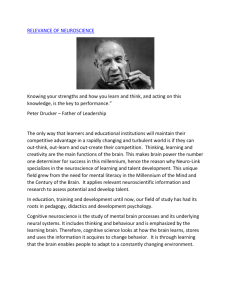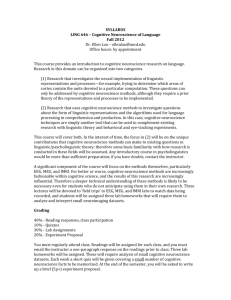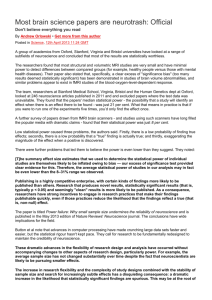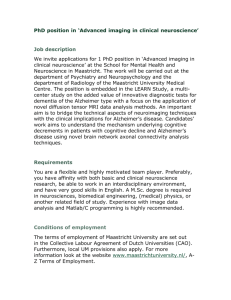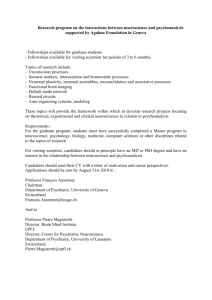Full reading list 2012-2015
advertisement
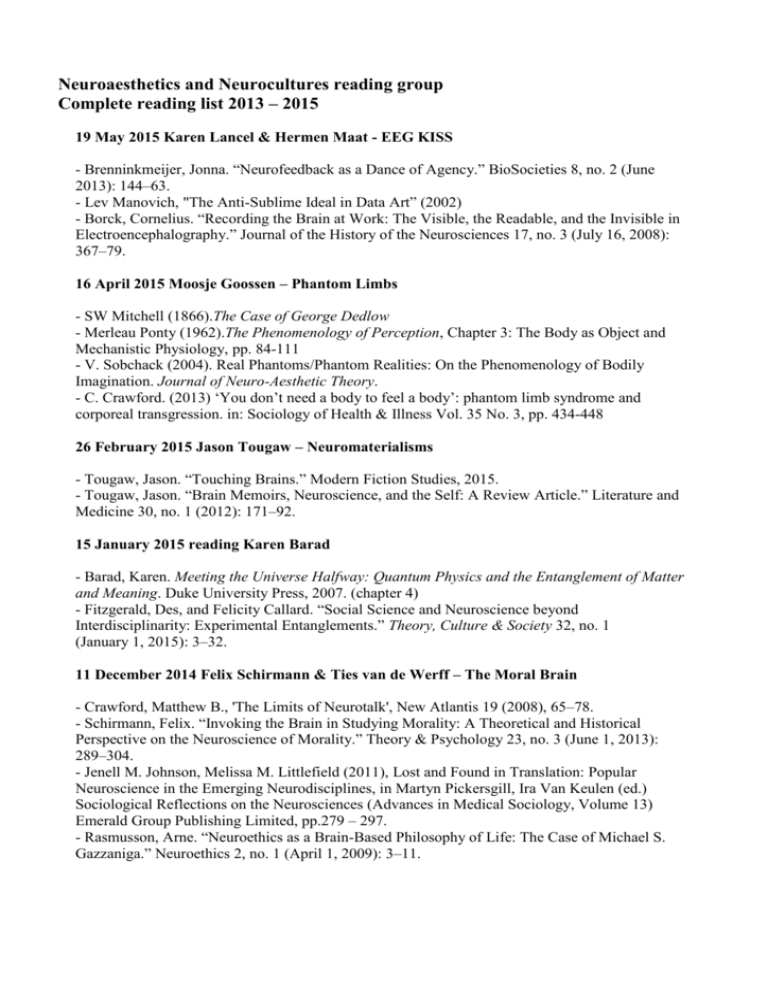
Neuroaesthetics and Neurocultures reading group Complete reading list 2013 – 2015 19 May 2015 Karen Lancel & Hermen Maat - EEG KISS - Brenninkmeijer, Jonna. “Neurofeedback as a Dance of Agency.” BioSocieties 8, no. 2 (June 2013): 144–63. - Lev Manovich, "The Anti-Sublime Ideal in Data Art” (2002) - Borck, Cornelius. “Recording the Brain at Work: The Visible, the Readable, and the Invisible in Electroencephalography.” Journal of the History of the Neurosciences 17, no. 3 (July 16, 2008): 367–79. 16 April 2015 Moosje Goossen – Phantom Limbs - SW Mitchell (1866).The Case of George Dedlow - Merleau Ponty (1962).The Phenomenology of Perception, Chapter 3: The Body as Object and Mechanistic Physiology, pp. 84-111 - V. Sobchack (2004). Real Phantoms/Phantom Realities: On the Phenomenology of Bodily Imagination. Journal of Neuro-Aesthetic Theory. - C. Crawford. (2013) ‘You don’t need a body to feel a body’: phantom limb syndrome and corporeal transgression. in: Sociology of Health & Illness Vol. 35 No. 3, pp. 434-448 26 February 2015 Jason Tougaw – Neuromaterialisms - Tougaw, Jason. “Touching Brains.” Modern Fiction Studies, 2015. - Tougaw, Jason. “Brain Memoirs, Neuroscience, and the Self: A Review Article.” Literature and Medicine 30, no. 1 (2012): 171–92. 15 January 2015 reading Karen Barad - Barad, Karen. Meeting the Universe Halfway: Quantum Physics and the Entanglement of Matter and Meaning. Duke University Press, 2007. (chapter 4) - Fitzgerald, Des, and Felicity Callard. “Social Science and Neuroscience beyond Interdisciplinarity: Experimental Entanglements.” Theory, Culture & Society 32, no. 1 (January 1, 2015): 3–32. 11 December 2014 Felix Schirmann & Ties van de Werff – The Moral Brain - Crawford, Matthew B., 'The Limits of Neurotalk', New Atlantis 19 (2008), 65–78. - Schirmann, Felix. “Invoking the Brain in Studying Morality: A Theoretical and Historical Perspective on the Neuroscience of Morality.” Theory & Psychology 23, no. 3 (June 1, 2013): 289–304. - Jenell M. Johnson, Melissa M. Littlefield (2011), Lost and Found in Translation: Popular Neuroscience in the Emerging Neurodisciplines, in Martyn Pickersgill, Ira Van Keulen (ed.) Sociological Reflections on the Neurosciences (Advances in Medical Sociology, Volume 13) Emerald Group Publishing Limited, pp.279 – 297. - Rasmusson, Arne. “Neuroethics as a Brain-Based Philosophy of Life: The Case of Michael S. Gazzaniga.” Neuroethics 2, no. 1 (April 1, 2009): 3–11. 13 November 2014 Tim Yaczo - Neurobananas - Gregor Noll "Weaponising Neurotechnology: International Humanitarian Law and the Loss of Language," from the London Review of International Law this year; - Michael Pollan "The Intelligent Plant," from the New Yorker last year; - William De Witt Snodgrass's poem "In Memory of Lost Brain Cells. 9 October 2014 Patricia Pisters – Neurocinematics, the Red Balloon - Shimamura, Arthur P. “Psychocinematics: Issues and Directions.” In Psychocinematics: Exploring Cognition at the Movies, edited by Arthur P. Shimamura, 1–26. Oxford University Press, 2013. - Smith, Tim J., Daniel Levin, and James E. Cutting. “A Window on Reality Perceiving Edited Moving Images.” Current Directions in Psychological Science 21, no. 2 (April 1, 2012): 107– 13. - Zacks, J. M., and J. P. Magliano. "Art and the Senses, chapter Film, Narrative, and Cognitive Neuroscience." Oxford University Press 87 (2010): 85. - Magliano, Joseph P., and Jeffrey M. Zacks. “The Impact of Continuity Editing in Narrative Film on Event Segmentation.” Cognitive Science 35, no. 8 (November 1, 2011): 1489–1517. - Zacks, Jeffrey M. “Constructing Event Representation during Film Comprehension.” In Psychocinematics: Exploring Cognition at the Movies, edited by Arthur P. Shimamura, 227– 43. Oxford University Press, 2013. 11 September 2014 Flora Lysen – cerebral subjecthood - De Vos, Jan. “The Iconographic Brain. A Critical Philosophical Inquiry into (the Resistance Of) the Image.” Frontiers in Human Neuroscience 8 (2014): 300. - Pickersgill, Martyn, Sarah Cunningham-Burley, and Paul Martin. “Constituting Neurologic Subjects: Neuroscience, Subjectivity and the Mundane Significance of the Brain.” Subjectivity 4, no. 3 (September 2011): 346–65. - Vidal, Fernando. “Fiction Film and the Cerebral Subject.” In Neurocultures: Glimpses Into an Expanding Universe, edited by Francisco Ortega and Vidal, Fernando. Peter Lang, 2010. 22 July 2014 – Flora Lysen & Max van der Linden - Cooter, Roger. “Neural Veils and the Will to Historical Critique: Why Historians of Science Need to Take the Neuro-Turn Seriously.” 2014 - Casper, Stephen T. “History and Neuroscience: An Integrative Legacy.” 2014 - Dumit, Joseph. “Afterword: Twisting the Neurohelix.” In The Neuroscientific Turn: Transdisciplinarity in the Age of the Brain, 2012. 12 June 2014 – Abe Geil – mirror neurons, cinema & face - selected parts of Abe’s dissertation “Plastic Recognition: The Politics and Aesthetics of Facial Representation from Silent Cinema to Cognitive Neuroscience” (2013) - Heyes, Cecilia. “Where Do Mirror Neurons Come From?” Neuroscience & Biobehavioral Reviews 34, no. 4 (March 2010): 575–83. - Leys, Ruth. “How Did Fear Become a Scientific Object and What Kind of Object Is It?” Representations 110, no. 1 (May 1, 2010): 66–104. 8 May 2014 Manon Parry - Medical museums and the history of mental health - Coleborne, Catharine, and Dolly MacKinnon. Exhibiting Madness in Museums: Remembering Psychiatry Through Collection and Display. Routledge, 2011. (selected chapters) - Lorimer, Anne. “Embodied Brains: Why Science Studies Needs the Anthropology of Museums.” In Technologized Images, Technologized Bodies, edited by Jeanette Edwards, Penelope Harvey, and Peter Wade, 85–117. Berghahn Books, 2010. 12 March 2014 Dolhuys Tour – ‘Dwalen door het brein’, Haarlem 13 February 2014 Patricia Pisters – Empathy & Mirror Neurons – Mediastudies room 1.12 - Pisters, Dexter’s Plastic Brain (publication in preparation) - Slaby, Jan. Against Empathy (online publication) - Slaby, Jan. “Empathy’s Blind Spot.” Medicine, Health Care and Philosophy 17, no. 2 (May 1, 2014): 249–58. - Wicker, Bruno, Christian Keysers, Jane Plailly, Jean-Pierre Royet, Vittorio Gallese, and Giacomo Rizzolatti. “Both of Us Disgusted in My Insula: The Common Neural Basis of Seeing and Feeling Disgust.” Neuron 40, no. 3 (October 30, 2003): 655–64. - Leys, Ruth. “‘Both of Us Disgusted in My Insula’: Mirror Neuron Theory and Emotional Empathy.” Nonsite.org, 2012. - Raz, Gal, Yael Jacob, Tal Gonen, Yonatan Winetraub, Tamar Flash, Eyal Soreq, and Talma Hendler. “Cry for Her or Cry with Her: Context-Dependent Dissociation of Two Modes of Cinematic Empathy Reflected in Network Cohesion Dynamics.” Social Cognitive and Affective Neuroscience 9, no. 1 (January 1, 2014): 30–38. - Freedberg, David, and Vittorio Gallese. “Motion, Emotion and Empathy in Esthetic Experience.” Trends in Cognitive Sciences 11, no. 5 (May 2007): 197–203. - Casati, Roberto, and Alessandro Pignocchi. “Mirror and Canonical Neurons Are Not Constitutive of Aesthetic Response.” Trends in Cognitive Sciences 11, no. 10 (October 2007): 16 January 2014 1. visit to the Symposium on Diepe hersenstimulatie (13.00-17.00) in Dutch @ Brakke Grond 2. visit to theatre Brakke Grond, Damiaan Denys & Bo Tarenskeen 7 January Flora Lysen & Max van der Linden (small café meeting) - Selected chapters from Borck, Cornelius. Hirnstrome. Eine Kulturgeschichte der Elektroenzephalographie, 2005. (In German) 10 October 2013- Tim Yaczo – Characterization / Brains in Character - Broks, Paul. Voodoo Child (Slight return), excerpt from: Broks, Paul. Into the Silent Land: Travels in Neuropsychology. Grove Press, 2004. - Malabou, Catherine. Changing Difference. Polity, 2011. (excerpt: ‘Gramatology & Plasticity’) -Gilbert, Frederic, Lawrence Burns, and Timothy Krahn. “The Inheritance, Power and Predicaments of the ‘Brain-Reading’ Metaphor.” Medicine Studies 2, no. 4 (May 1, 2011): 229–44. - Galloway, Alexander R. “Plastic Reading.” Novel 45, no. 1 (March 20, 2012): 10–12. - Birge, Sarah. “Brainhood, Selfhood, or ‘Meat with a Point of View’: The Value of Fiction for Neuroscientific Research and Neurological Medicine.” In The Neuroscientific Turn: Transdisciplinarity in the Age of the Brain, edited by Melissa M. Littlefield and Jenell Johnson, 89–105 4 December 2013- Daisy van der Zande - Cognitive work of cinema - Blassnigg, Martha. "Revisiting Marey’s Applications of Scientific Moving Image Technologies in the Context of Bergson’s Philosophy: Audio-Visual Mediation and the Experience of Time." Medicine Studies 2.3 (2010): 175-184. - Stafford, Barbara Maria. “How Patterns Meet: From Representation to Mental Representation.” Echo Objects: The Cognitive Work of Images. Chicago, London: University of Chicago Press, 2007. 135 – 173. - Stafford, Barbara Maria. “Introduction.” & “Form as Figuring it Out: Toward a Cognitive History of Images.” Echo Objects: The Cognitive Work of Images. Chicago, London: University of Chicago Press, 2007. 1 – 42. - Elsaesser, Thomas and Malte Hagener. “Cinema as Brain: Mind and Body.” Film Theory: An Introduction Through the Senses. New York: Routledge, 2010. 149 – 169. 12 September 2013 – Annelies Kleinherenbrink – Gender & Neuroscience * Pitts-Taylor, Victoria. 2012. Neurocultures Manifesto. Error! Hyperlink reference not valid. * Introduction of Neurofeminism: Issues at the Intersection of Feminist Theory and Cognitive Science, edited by R. Bluhm, A.J. Jacobson, and H.L. Maibom, 105-120. * Jordan-Young, Rebecca and Rumiati, Raffaella, 2012. “Hardwired for sexism? Approaches to Sex/Gender in Neuroscience” In Neurofeminism: Issues at the Intersection of Feminist Theory and Cognitive Science, edited by R. Bluhm, A.J. Jacobson, and H.L. Maibom, 105-120. Palgrave Macmillan, 2012 * Roy, Deboleena, 2012. “Neuroethics, Gender and the Response to Difference.” Neuroethics 5, no. 3: 217–230 * Kraus, Cynthia, 2012. “Critical Studies of the Sexed Brain: A Critique of What and for Whom?” Neuroethics 5, no. 3: 247–259. * Joel, Daphna. 2011. “Male or Female? Brains Are Intersex.” Frontiers in Integrative Neuroscience 5: art. 57. 13 June 2013 - Julian Kiverstein - Rose, N., & Abi-Rached, J. M. (2013). Neuro: The New Brain Sciences and the Management of the Mind. Princeton University Press. [selected chapters] 11 April 2013 -Stephan Besser - The Encultured Brain (bridging neuroscience and cultural sciences) - Abi-Rached, J. M., and N. Rose. “The Birth of the Neuromolecular Gaze.” History of the Human Sciences 23, no. 1 (2010): 11–36. - Besser, draft article “Poetics of the Neuromolecular Gaze” 21 March 2013 - Flora Lysen – Metaphors of the Mind & Brain - Borck, C. (2011). Toys are us. Models and metaphors in brain research. In S. Choudhury & J. Slaby (Eds.), Critical Neuroscience (pp. 111–133). Oxford, UK: Wiley-Blackwell. - Draaisma, D. (2000). Metaphors of Memory: A History of Ideas about the Mind. Cambridge University Press. (selection) - Hagner, M. (2009). The Mind at Work: the Visual Representation of Cerebral Processes. In R. van de Vall & R. Zwijnenberg (Eds.), The Body Within: Art, Medicine & Visualization. Brill. - Goschler, Juliana. “Metaphors in Cognitive and Neurosciences.” Metaphorik.de 12, no. Special issue on Metaphors in Science and Technology (2007). http://www.metaphorik.de/12/goschler.pdf. 14 February 2013 - Patricia Pisters – Neurocultures and film - Brain, R. M. (2012). Self-Projection: Hugo Münsterberg on Empathy and Oscillation in Cinema Spectatorship. Science in Context, 25(03), 329–353. - Bruno, G. (2009). Film, Aesthetics, Science: Hugo Münsterberg’s Laboratory of Moving Images. Grey Room, 36, 88–113. - Pisters, P. (2012). Illusionary Perception and Powers of the False. In The Neuro-Image: A Deleuzian FilmPhilosophy of Digital Screen Culture. Stanford University Press. Film viewings Brainstorm, Douglass Trumbull, 1983 Altered States, Ken Russell, 1980 Mon Oncle d’Amerique, Alain Resnais, 1980


